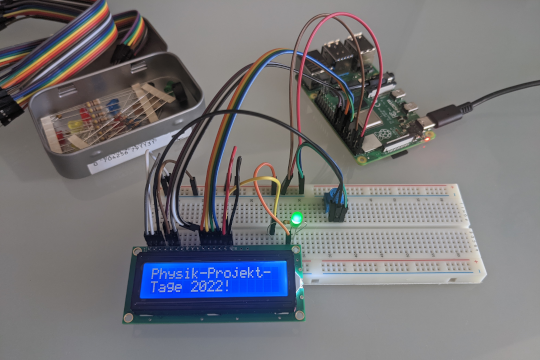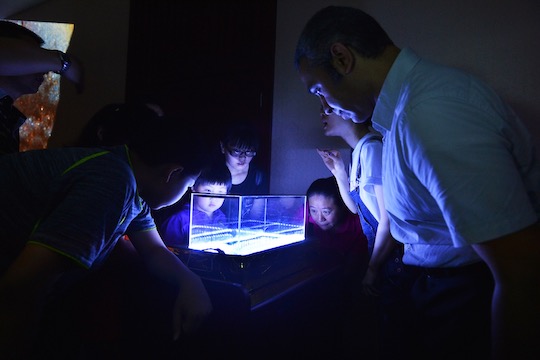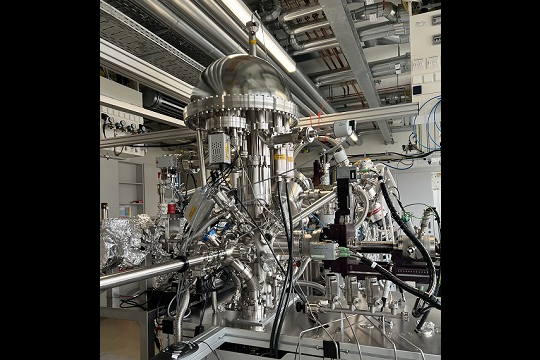Rückblick: PPT Hamburg 2023
Herzlich Willkommen bei den Physik-Projekt-Tagen 2023 in Hamburg!
Hier erhaltet ihr einen Einblick in das Programm der PPT 2023 in Hamburg und könnt auch noch einmal die Projekte durchstöbern, an denen die Teilnehmerinnen gearbeitet haben.
Rechts auf der Seite findet ihr außerdem die Links zu den PPT-Veranstaltungen in Kiel aus den Jahren 2014, 2016 und 2018 und zu den PPT 2018 und 2022 in Hamburg.
Außerdem findet ihr dort weiterführende Links zu den Seiten unseres Fachbereichs und unseres Instituts sowie zu unseren Förderern und weiteren interessanten Projekten.
Projekte PPT 2023 Hamburg
















Suche nach dem Higgs-Boson

Holografie
Auch wenn es sich bei der Holografie um eine schon ältere Technik handelt, deren Grundlagen in den 40er Jahren des letzten Jahrhunderts erarbeitet wurden, ist sie immer noch bzw. zum Teil auch wieder zunehmend in der aktuellen Forschung zu finden. In diesem Versuch werden wir opto-mechanische Aufbauten zur Erzeugung von Hologrammen in einem Optik-Labor realisieren und natürlich auch einige Hologramme aufnehmen. Dabei lernt man einiges über die wellenoptischen Eigenschaften von Licht, wie z.B. über das Phänomen der Interferenz.
Dieses Projekt richtet sich an Teilnehmerinnen ab 18 Jahren.

Machine Learning
Dies ist ein Deutsch-Englisches Projekt. Die Sprache der Wissenschaft ist Englisch und besonders als Physiker*in ist es wichtig, diese Sprache gut zu beherrschen. Aber keine Sorge - es wird bei diesem Versuch auch immer jemand dabei sein, der Deutsch spricht, also lasst euch hiervon nicht abschrecken.
In den letzten Jahren hat maschinelles Lernen in vielen verschiedenen Bereichen einen riesigen Boom erfahren, nicht nur in der Tech-Branche sondern auch in der Wissenschaft. Anwendungen maschinellen Lernens begegnen uns im täglichen Leben an verschiedensten Stellen, von der Entsperrung unserer Smartphones mittels Face-ID, über die automatische Hervorhebung von Beiträgen in sozialen Medien, bis hin zu den Vorschlägen die uns von Netflix gemacht werden. Maschinelles Lernen hilft auch Physiker*innen bei der Suche nach neuen Elementarteilchen, Ärzten und Ärztinnen bei der Erstellung von Diagnosen und in vielen anderen Gebieten der Wissenschaft. Aber wie funktionieren diese Algorithmen überhaupt? In diesem Projekt werdet ihr entdecken welche “Magie” hinter maschinellem Lernen steckt und wie man es sowohl im Alltag als auch zum Lösen von wissenschaftlichen Problemen verwenden kann. Seid ihr bereit eure eigenen neuronalen Netzwerke zu entwerfen? Machine learning has had a huge boom in recent years in many different fields of knowledge, with a large impact not only in the tech industry but also in science. We experience many applications of machine learning in our daily life, such as using Face ID to unlock our phones, highlighting posts on social media or suggesting what to watch on Netflix. Machine learning is also helping physicists in their quests for new particles, assisting doctors in their medical diagnoses, and advancing many other scientific activities. But how do these algorithms actually work? In this project you will discover the “magic” behind machine learning, and how it can be put into practice to solve both everyday-life and scientific problems! Ready to be the architect of your own neural network?
Laboraufbau mit Einplatinencomputer (Programmieren mit dem Raspberry Pi)
Insight on Semiconductors
Dies ist ein Deutsch-Englisches Projekt. Die Sprache der Wissenschaft ist Englisch und besonders als Physiker*in ist es wichtig, diese Sprache gut zu beherrschen. Aber keine Sorge - es wird bei diesem Versuch auch immer jemand dabei sein, der Deutsch spricht, also lasst euch hiervon nicht abschrecken.
Semiconductor materials have an electrical conductivity which lies between conductors and insulators. Its electrical properties may be altered in useful ways by introducing impurities in the material (known as “doping”), by applying electric or magnetic fields, or by exposing the material to light or heat. Thus, semiconductors can make excellent sensors.
Many of the components you find in every electrical device are semiconductors. In particle physics, semiconductor devices are used as particle detectors. The particles interact with the semiconductor material and this interaction is transformed into an electrical signal, which is used to study the particle’s properties. At DESY, we study semiconductor sensors to develop new detectors for the next generation of particle physics experiments.
Understanding the behavior of semiconductors under a given configuration is very important for the development process. Technology Computer-Aided Design (TCAD) is a simulation tool that can help with this understanding, because it can replicate the fabrication process of semiconductors and the conditions under which they are used. With TCAD simulations it is possible to see effects that are not usually visible or measurable, such as the electric field inside a sensor, as well as measurable quantities, such as the breakdown voltage.
In this project you will have the opportunity to dive into the inner structures of semiconductors using TCAD and to understand the effects of different configurations. We will then compare the observations made in simulations with small laboratory experiments using different semiconductor devices.

Molecule bursts by X-rays
Dies ist ein Deutsch-Englisches Projekt. Die Sprache der Wissenschaft ist Englisch und besonders als Physiker*in ist es wichtig, diese Sprache gut zu beherrschen. Aber keine Sorge - es wird bei diesem Versuch auch immer jemand dabei sein, der Deutsch spricht, also lasst euch hiervon nicht abschrecken.
Hamburg accommodates one of the most powerful X-ray sources in the world, the European X-Ray Free-Electron Laser (XFEL). This facility is capable of generating flashes of X-rays with extreme properties. These flashes are • ultrashort: their duration is as short as 10 femtoseconds (1 fs = 10^(-15) s) (For comparison: Within 10 fs light travels 3 micrometers, one-tenth of the thickness of a hair! Within 10 fs atoms at room temperature are practically motionless!) • ultraintense: their intensity may reach 10^23 W/m^2 (For comparison: One could reach such light intensity by focusing all the sunlight illuminating the Earth down to 1 mm radius!) Due to these extreme properties, XFEL technology is revolutionizing many areas of science, e.g., the determination of complex molecular structures using the scattering of X-rays. Still, as the dominant interaction process between X-rays and matter is the photoelectric effect, rather than scattering, the radiation used for probing may itself alter the structure of matter. Therefore, understanding the impact of an ultraintense, ultrashort flash of XFEL light on a sample is of crucial importance. Within this project we are going to investigate, via computer simulations, the XFEL-induced behavior of small molecules. For this we are going to use a dedicated computer program called XMDYN. After a short introduction and review of the necessary physics background the team will obtain insight into this exciting field via performing their own scientific investigations. This includes running simulations, visualizing atomic motions in molecules, and analyzing the results.
Silizium Streifen Sensoren
Teilchendetektoren sind ein wichtiger Bestandteil eines jeden Teilchenphysik Ex- periments. Sie dienen der Identifikation von Teilchen, die beispielsweise in einer Proton-Proton Kollision am Large Hadron Collider (LHC) entstehen.
Silizium Streifen Sensoren sind eine Art von Teilchendetektoren, die häufig in Teilchenphysik Experimenten verwendet werden. Wenn geladene Teilchen diese Sensoren durchkreuzen, wird ein elektrisches Signal erzeugt. Dieses Signal wird ausgewertet, um Informationen über die Position der Teilchen zu erhalten. Meist wird eine Vielzahl der Sensoren in mehreren Lagen angeordnet, um die Flugbahn geladener Teilchen zu bestimmen.
In diesem Projekt wirst Du lernen, wie Silizium Detektoren funktionieren und wie diese in der Teilchenphysik eingesetzt werden können. Außerdem wirst du charakteristische Eigenschaften der Sensoren vermessen.

Jage das Unsichtbare
Dies ist ein Deutsch-Englisches Projekt. Die Sprache der Wissenschaft ist Englisch und besonders als Physiker*in ist es wichtig, diese Sprache gut zu beherrschen. Aber keine Sorge - es wird bei diesem Versuch auch immer jemand dabei sein, der Deutsch spricht, also lasst euch hiervon nicht abschrecken.
Kosmische Strahlung sind sehr energetische (schnelle) Teilchen, die die Erde von außerhalb ihrer Atmosphäre erreichen (vor allem von außerhalb des Sonnensystems). Die Anzahl der kosmischen Strahlung wird größer, je höher wir gehen, was darauf hinweist, dass sie aus dem Weltraum kommen (nicht vom Erdkern!). Fast 90% der kosmischen Strahlung, die die Erdatmosphäre treffen sind Wasserstoffatomkerne (also Protonen), 9% Helium Atomkerne (also Alpha (α)-Teilchen) und 1% sind Elektronen. Es ist richtig, dass die kosmischen Teilchen um uns sind. Diese Tatsache gibt uns die großartige Chance, diese Teilchen zu Erkennen und dies mit sehr einfachen und billigen Werkzeugen. In diesem Projekt werden wir eine einfache selbstgebaute Nebelkammer verwenden, um die kosmische Strahlung zu studieren und zu sehen ... Live!!
Generation of ultrashort laser pulses
Dies ist ein Deutsch-Englisches Projekt. Die Sprache der Wissenschaft ist Englisch und besonders als Physiker*in ist es wichtig, diese Sprache gut zu beherrschen. Aber keine Sorge - es wird bei diesem Versuch auch immer jemand dabei sein, der Deutsch spricht, also lasst euch hiervon nicht abschrecken.
The time it takes for an electron to make a complete round-trip around the hydrogen atom is 150 attoseconds. This is 0.000 000 000 000 000 150 seconds! In order to study such fast phenomena in atoms and molecules, we need to produce ultrashort laser pulses.
In this project, you will work with a hollow-core fiber setup that is a tool for generating ultrashort femtosecond (1 fs = 10^(-15) s) laser pulses. The working principle of this technique is based on the concept that the more colors a light pulse contains, the shorter it can become in time. By entering a hollow-core fiber filled with a noble gas the light is guided and new colors are created, resulting in a shorter laser pulse at the output. During the activity, you will take care of coupling a laser beam into a fiber, from the optimisation to the complete characterisation of the output beam. Are you ready to work with a colorful setup?
About the CFEL-ATTO group at DESY: our team aims at observing and manipulating the fastest movements in molecules that happen at ultrafast timescales, from femtosecond to attosecond. In order to capture these events, we need to generate light flashes with a temporal duration in the same range and use them within an ultrafast camera for our molecular movies.

Design of a hybrid material
Dies ist ein Deutsch-Englisches Projekt. Die Sprache der Wissenschaft ist Englisch und besonders als Physiker*in ist es wichtig, diese Sprache gut zu beherrschen. Aber keine Sorge - es wird bei diesem Versuch auch immer jemand dabei sein, der Deutsch spricht, also lasst euch hiervon nicht abschrecken.
Hybrid plasmonic materials consisting of plasmonic nanostructures and porous microstructures have shown a lot of interest in recent years due to their unique combined properties. Among plasmonic nanostructures, gold nanoparticles (GNPs) are excellent candidates for the construction of hybrid plasmonic materials because of their controllable size, unique optical properties, and ability to bind to various molecular species. Alterations in their shape, surface modification, and size as well as modifying the interparticle spacing of aggregates can enhance their plasmonic behavior. On the other hand, porous silicon (pSi) represents a versatile host material for the deposition of GNPs. It offers pores with controllable size, porosity, and a wide surface area, which could enable the control of the interparticle interaction between GNPs, therefore improving the plasmonic behavior of GNPs. Then, the incorporation of GNPs into the pores of pSi membranes opens a new direction for different technological applications, for example, biosensors, gas sensors, medical devices, and surface-enhanced Raman spectroscopy (SERS) substrates.
In this project, you will learn the synthesis, functionalization, and characterization of gold nanoparticles as well as their incorporation into the pores of porous silicon membranes to generate hybrid plasmonic materials. Finally, you will be able to see your hybrid material under the scanning electron microscope (SEM).

Optische Pinzette

Roboter

See an atom with X-rays
Dies ist ein Projekt in englischer Sprache.
You probably know about the atomic structure: there is a positively charged nucleus and negatively charged electrons are spinning around the nucleus. Understanding of the atomic structure is the essence of quantum mechanics. Most likely, you've heard of x-rays, too. With x-rays, medical doctors can see bones inside your body at the hospital and security staff can detect small gadgets inside your luggage at the airport. Researchers can also see protein structures with more advanced x-ray beams, for example produced by PETRA III at DESY, Hamburg. In this project, you can investigate the atomic structure with x-rays! We will go over basic interactions of x-rays with atoms, we will explore how x-rays can remove electron(s) from an atom, how the atom reacts subsequently, and then how deep we can see inside the atom itself on a computer. You will learn how to use a dedicated computer program called XATOM and do exciting numerical experiments to look into the atomic structure by using x-rays.
X-ray Photoelectron Spectroscopy
Dies ist ein Projekt in englischer Sprache.
XPS steht für Röntgenphotoelektronenspektroskopie (X-ray Photoelectron Spectroscopy) - eine der wichtigsten Methoden zur Untersuchung der chemischen Zusammensetzung von Oberflächen. Hier könnt ihr die chemische Zusammensetzung sowie die Bindungsverhältnisse der elektronischen Struktur an der Oberfläche bestimmter Proben herausfinden. Ihr könnt eine direkte Anwendung des Photoeffektes beobachten und lernen, wie konkrete Bestandteile der Probenoberfläche identifiziert werden können. Die Arbeit findet an modernsten Geräten statt. Neben dem Analysieren von Proben lernt ihr außerdem wichtige Infos zur Nutzung von Vakua in der Forschung und vieles mehr.Eindrücke von den PPT 2023 in Hamburg




Roboter
Programm PPT 2022
Das war unser Programm der PPT 2023 vom 30. August bis 2. September.

Ein Projekt des

Vielen Dank an unsere Unterstützer:





